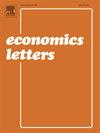欧盟的人工智能和通货膨胀
IF 1.8
4区 经济学
Q2 ECONOMICS
引用次数: 0
摘要
我们研究了人工智能的采用对欧盟经济部门生产者价格通胀的影响。我们发现,人工智能的扩散与通胀压力的降低有关,在服务业和欧元区的影响在统计上最为显著。使用人工智能的公司比例每增加10个百分点,平均而言,通货膨胀率就会下降0.3-0.6个百分点。采用人工智能与通货膨胀之间的关系是非线性的。在人工智能密集型行业,通货紧缩对价格的影响更为明显。总体而言,研究结果表明,人工智能技术的整合构成了抑制通胀的结构性力量。本文章由计算机程序翻译,如有差异,请以英文原文为准。
Artificial intelligence and inflation in the EU
We investigate the influence of artificial intelligence adoption on producer price inflation across economic sectors within the European Union. We show that AI diffusion is associated with reduced inflationary pressures, with effects most statistically significant in services and the Eurozone. A 10–percentage-point increase in the share of firms employing AI corresponds, on average, to a 0.3–0.6 percentage-point decline in inflation. The association between AI adoption and inflation is nonlinear. The deflationary impact on prices is more pronounced in AI-intensive sectors. Overall, the findings suggest that the integration of AI technologies constitutes a structural force dampening inflation.
求助全文
通过发布文献求助,成功后即可免费获取论文全文。
去求助
来源期刊

Economics Letters
ECONOMICS-
CiteScore
3.20
自引率
5.00%
发文量
348
审稿时长
30 days
期刊介绍:
Many economists today are concerned by the proliferation of journals and the concomitant labyrinth of research to be conquered in order to reach the specific information they require. To combat this tendency, Economics Letters has been conceived and designed outside the realm of the traditional economics journal. As a Letters Journal, it consists of concise communications (letters) that provide a means of rapid and efficient dissemination of new results, models and methods in all fields of economic research.
 求助内容:
求助内容: 应助结果提醒方式:
应助结果提醒方式:


